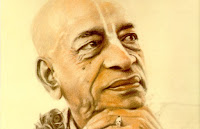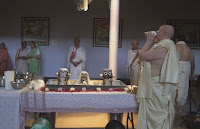
Lifestyle of a Monk.
This is an article which appeared in the Gujarati News Magazine, known as Chitralekha.
It is very interesting to know that how monks or sadhus receive training in ISKCON, the International Society for Krishna Consciousness. Like other institutions, which follow the teachings of Sanatana-dharma, one of the important aspects of training in ISKCON is to become well-versed in the study of the Sastras or the Vedic scriptures. ISKCON has established various centers all over the world, and especially in India to give training to individuals who desire to dedicate their lives to the service of God and humanity. The various centers are located in Vrindavana, West Bengal, Mayapur, Mumbai, etc. There is one such center located in the outskirts of Mumbai in a village known as Galtare. There ISKCON Chowpatty has developed an eco-friendly project called Govardhan Ecovillage. In the serene atmosphere of the eco-village is established, the Bhaktivedanta Vidyapitha, to give systematic training to aspiring sadhus in scriptures. The Vidyapitha provides a full-time residential course of 2 years, in the study of two prominent scriptures; the Srimad Bhagavatam and the Caitanya Caritamrita.
How do individuals get an experience in the lifestyle of Bhakti in ISKCON? The manager of the operations Team at GEV, Jadhu Thakur Das, gave a reply to this question.
He said – All over the world in various institution and corporate worlds, ISKCON conducts various sessions/seminars on topics like “Search for Happiness”, “Power of Mind Control”, etc. Through such seminars, some people express an interest in knowing more about what is the lifestyle of a devotee in the Hare Krishna movement. They are advised to chant Hare Krishna Mahamantra every day, read scriptures regularly and to follow the four regulative principles – No meat eating, no gambling, no illicit sex and no intoxication.
To give them a practical experience of such lifestyle, in different countries, we have developed Bhaktivedanta Academy for Culture and Education (BACE). It is a stay facility wherein 10-12 bachelors stay together and practice the process of Bhakti under the guidance of a senior person. Simultaneously they continue their prescribed occupational duties i.e. their professional work. After a stay for at least one year in BACE, an aspiring monk gets a chance to stay in the temple, at the same time continue their professional duties. They mandatorily need to attend the morning program which starts at morning 4:30 am. This includes Mangal Aarti, Tulsi Puja, Chanting and Srimad Bhagavatam class. Then they set off to their jobs during the day time. After a year of such training, they undergo further training as a monk (Brahmachari Ashram)) or enter into married life (Grihastha Ashram). The aspiring monks are provided a brahmachari training for one year, which includes the study for becoming a Bhakti Sastri and also they are engaged in various services like temple cleanliness, assistants in puja-vidhi, book distribution, etc. The course of Bhakti Sastri includes the study of 4 books- Bhagavad Gita, Sri isopanisad, Bhakti Rasamrita Sindhu and Upadeshamrita.
The Dean of Bhaktivedanta Vidyapitha, Gaurang Darshan Das, a highly educated sadhu, tells us more about the vision of Vidyapitha. He has a Masters degree in System Science and automation from ISC Bangalore.
He said – The vision of Vidyapitha is to inspire and inculcate Vaishnav qualities and a mood of selfless service in the students. Our sutra is Truth, Tradition and Transformation. Bhaktivedanta Vidyapitha facilitates the study of the Absolute Truth in a Traditional method that leads to the Transformation of the hearts of the students. The course is based on the 5s model.
Sadhana which includes rising up early in the morning, attending Mangal aarti, chanting japa, kirtan and attending Srimad Bhagavatam class.
Svadhyaya – Study of Vedic Scriptures systematically which includes hearing, recollection, contemplation and speaking of the scriptures. Also learning scriptural verses.
Seva – service in GEV departments, BVVP services and Deity services.
Sangh – Through classes and study groups, assignments and presentations, retreats and Get-together.
Sadachara – BVVP aims at training the students not only academically, but also as sincere and civilized individuals with exemplary Vaishnava behavior. Exclusive sadachara classes are conducted for the students.
The current batch which has joined BVVP has students from different states in India like Haryana, Bihar, Himachal Pradesh, Karnatak, Orissa, Tamil Nadu , Gujarat and Jammu. The students joining the course are highly qualified people from various fields. We have one students with double PHD, 2 PHD students, one Doctor, one from IIT, an NRI from Maurtius, a student from new Zealand and many more. The everday schedule for the course is like this – 3 hrs of lecture, then whole day the students are absorbed in studying and preparation of exam for the next day. This schedule is applicable for 5 weekdays. In weekends, they have their services in GEV. After their training in Vidyapitha, the students get engaged in various projects or services in different ISKCON temples. Furthur, after couple more years, they accept the saffron cloth of a renunciant. These highly qualified monks or brahmacharies serve without any remuneration or salary.
Jadu Thakur Das further said – In GEV – we have a Goshala, eco-friendly cottages, a forest which is a replica of Vrindavan, beautiful landscapes, vegetable and fruit gardens, etc. All these is developed by local monks staying here. In the 40 km radius, GEV conducts its various activities like preaching activities, education of poor children, helping them with their primary and secondary education. Not only that, to refrain people from going to cities in search of earning their livelihood, GEV has employed them in its VADI project which helps them in doing sustainable farming, earning a good income by using their own land. For Eg: By the cultivation of mogra and getting it distributed. The villagers who were earning 10000 rupees per year are now earning 80000 rupees per year.
Also, in GEV, we grow different varieties of rice. We have even recovered the rare rich quality of rice which was almost extinct. Rain prediction techniques are developed based on witnessing the direction of air during specific period/day of the year known as Akhatija.
The inspiration behind all these different activities in GEV is HH Radhanath Swami. He was born in Chicago. He got initiated by AC Bhaktivedanta Swami Srila Prabhupada in the year 1971. He is the main guiding force in GEV and also of the many projects of ISKCON running in Mumbai.
















 By Danavir Goswami
By Danavir Goswami


 Los Angeles Premiere Of Hare Krishna! The Film (Album with photos)
Filmmakers John and Jean Griesser with founding director of the Global Media ...
Los Angeles Premiere Of Hare Krishna! The Film (Album with photos)
Filmmakers John and Jean Griesser with founding director of the Global Media ... By Hari Parsada Dasa
By Hari Parsada Dasa